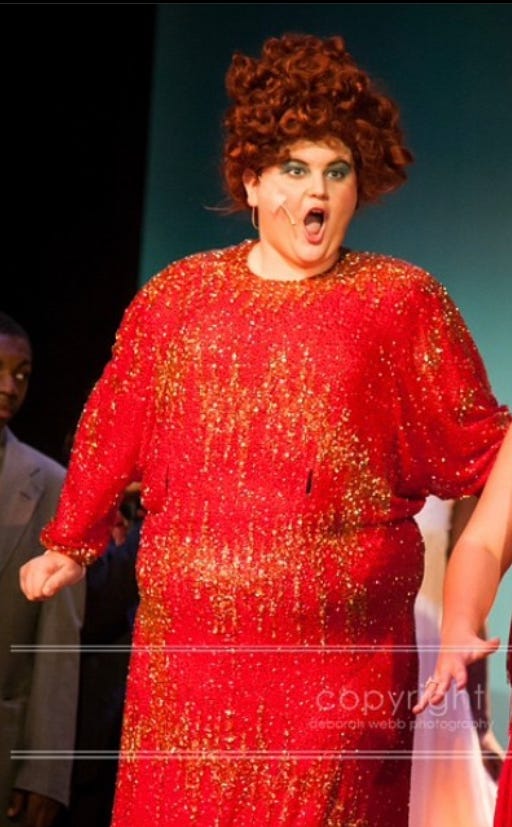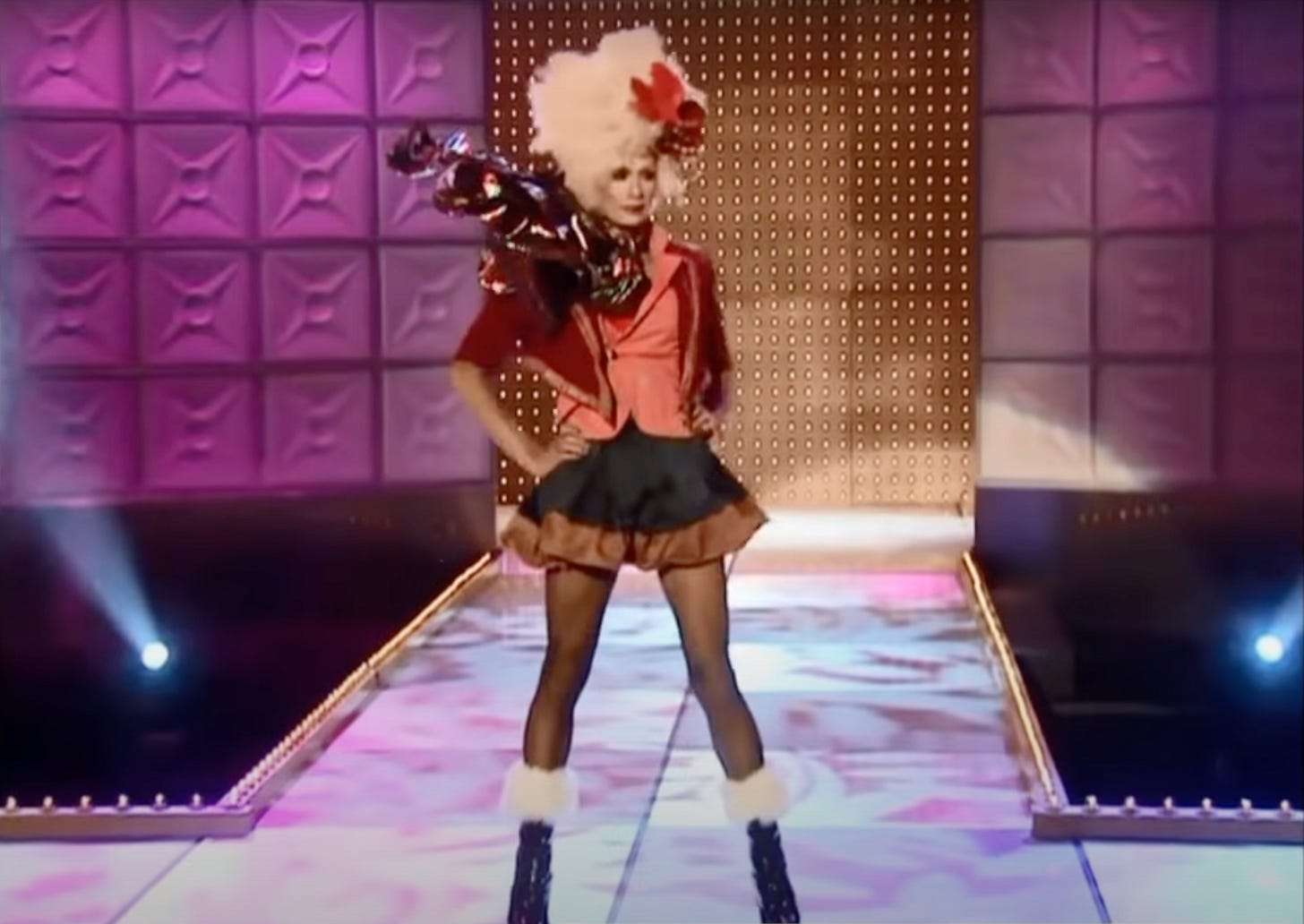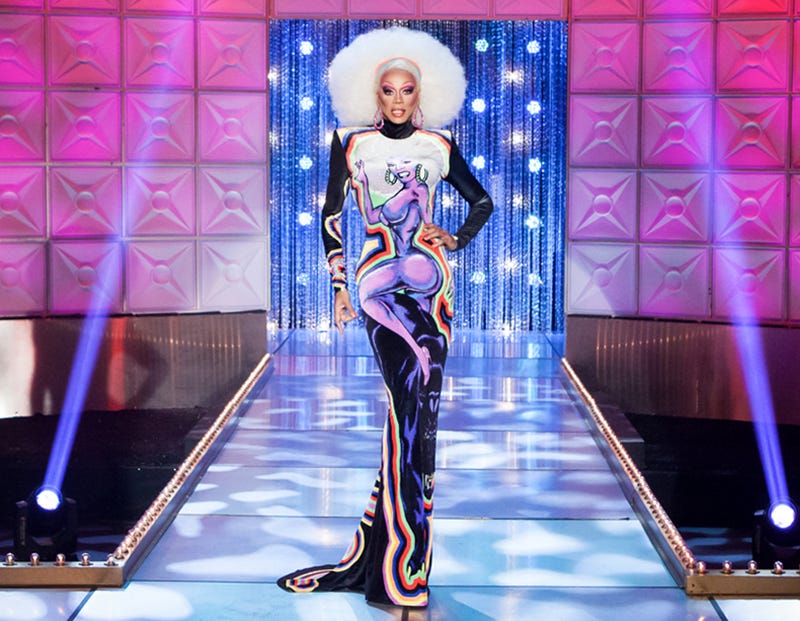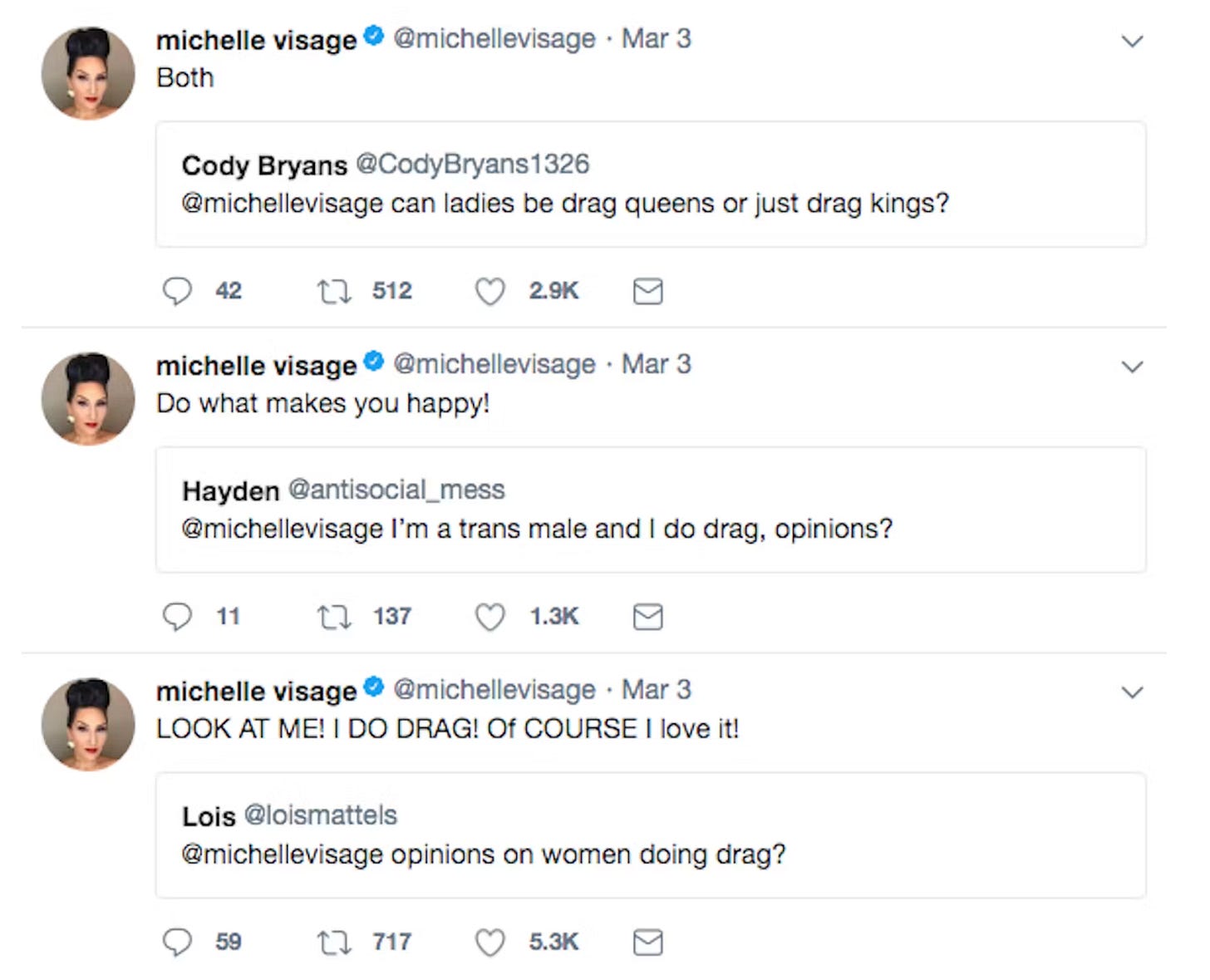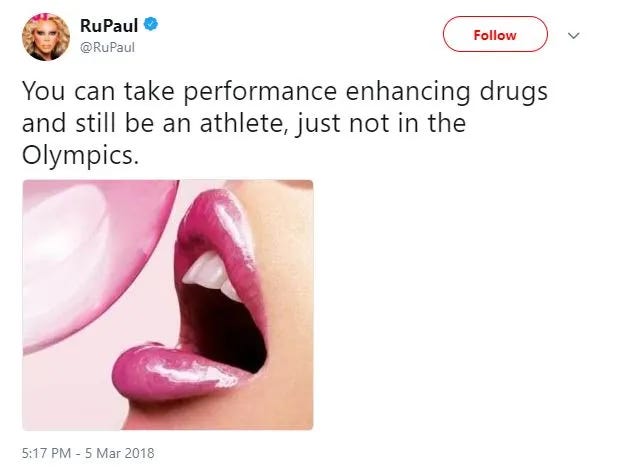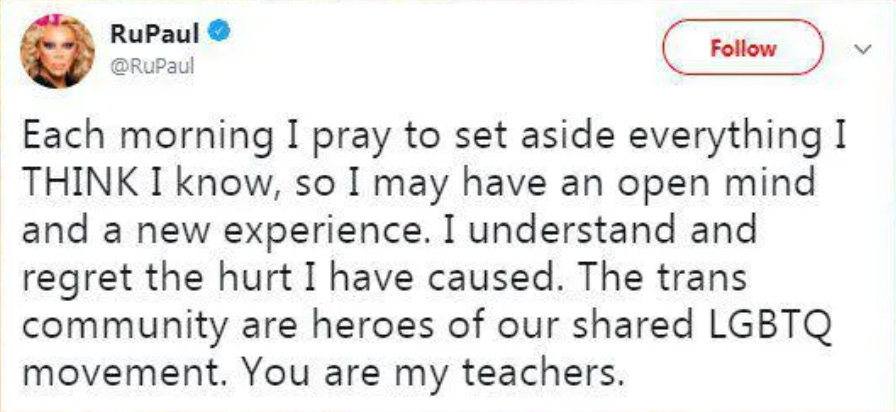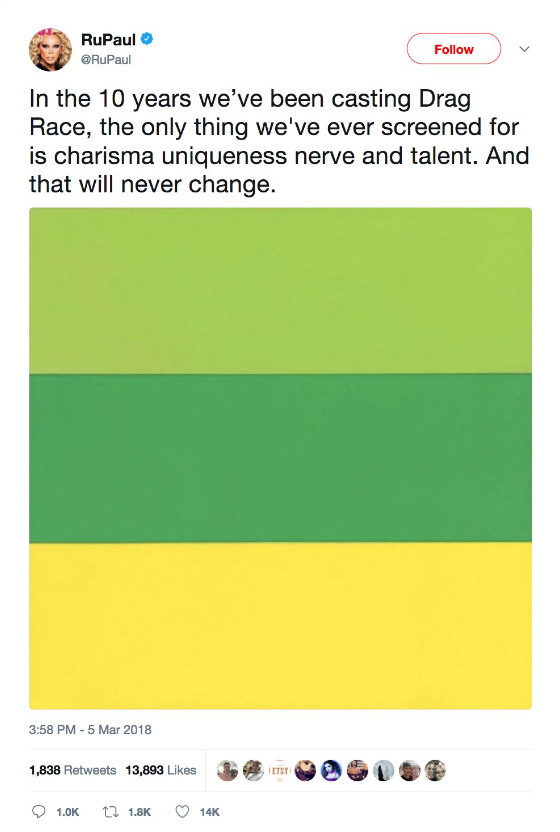The RuPaul Profile That Changed Everything
How we got from talk of “performance enhancing drugs” to Sasha Colby’s America
I started watching RuPaul’s Drag Race when I was thirteen. It’s funny to write that statement understanding that, if I were thirteen now, nearly a decade on, some GOP hack would use it as an argument to take me away from my parents. Anyways, a short time after I first heard about the show, I was cast as Edna Turnblad, a part that is traditionally played in drag, in a summer stock production of Hairspray Jr. Like any good actor, I understood that I needed to do some research. It was incumbent upon me to figure out what this whole “drag” thing was about; therefore, what I understood was a drag TV show would be an appropriate first stop. There also existed a concealed curiosity towards the show because I knew it to be queer. I’ve written before in this newsletter about how I’ve always intrinsically felt different from most other people. While I’ve realized that, ultimately, it’s a constellation of aspects that make me unique compared to the average person (if such a being really exists), my queerness is a significant celestial body in that galaxy, and, at the time, like a gay Galileo, I was just beginning to chart those stars. Along with allowing me to understand Edna a bit more, I was hoping that RuPaul’s Drag Race would also help me to get to know myself a bit better.
Almost immediately, the show did that and more. I instantly found myself entranced by each cast of audacious and talented performing artists vying for the title of America’s Next Drag Superstar; a title that, back then, meant so little, and yet so much. I remember watching Raja turn the corner in her best Christmas couture, belly laughing at Jinkx Monsoon’s impersonation of Little Edie, and being stunned at the disqualification of Willam (who remains my favorite RuGirl). During this time, the show had this sort of high earnestness, meaning that it was genuinely earnest without trying to be (as opposed to the more intentional and, thus, lower earnestness of the show’s current iteration). It was a show about performing artists showing up because they loved their art form. There was no expectation of international fame, or an influx of Instagram followers. It was like nothing I had ever seen before, and, as a budding artist, I felt so constantly inspired by the dedication these performers had to their art. It’s what keeps me coming back to Drag Race ten years later: I love seeing people excel at what they do at the highest level.
Acting as the paragon to this highest level of drag, there was the alien superstar that is RuPaul. A drag queen who, past one of her primes, created what was supposed to be a spoof of both America’s Next Top Model and Project Runway. However, through her effortless ebullience, impressive vulnerability, and all around charisma, uniqueness, nerve, and talent, RuPaul managed to make a show that eclipsed both those inspirations in critical acclaim and cultural relevance. There are, of course, many others who have contributed to the show’s massive success, but the fact remains that there’s no RuPaul’s Drag Race without RuPaul.
Not only was RuPaul the epitome of drag, but, with the success and popularity of Drag Race, she also became the primary arbiter of queer culture. This was because, along with introducing its audience to the “future” of drag through their contestants, Drag Race introduced younger generations of queer people to cultural touchstones like Paris is Burning, the B-52s, and Joan Crawford, to name just a few. Without Drag Race, I still might not know the correct answer to the question, “how is your head?” In my experience, Drag Race’s ability to pluck these cultural heirlooms out of obscurity also reproduced a new generation of queer kinship. I have vivid memories of my friends and I quoting Shangela’s “I don’t have a sugar daddy” speech back and forth to one another during rehearsals for whatever show we were in. Even now, my friend Tegan and I text about each new episode of the current season of Drag Race UK. Therefore, it is my contention that, along with being a nationally televised talent show, Drag Race had also become this encyclopedia for queer people to reference in order to bond with one another. While there was a whole staff of people to credit with Drag Race becoming this queer cultural exemplar, again, RuPaul loomed as the most responsible for this phenomenon.
This deification of RuPaul made a series of comments made by the so-called Queen of Drag all the more shocking. During the promotion cycle for the tenth season of Drag Race, RuPaul sat down with Decca Aitkenhead for a profile, published in The Guardian, that would instantaneously transform her public perception. In a primer on Drag Race preceding her profile of the Supermodel of the World, Aitkenhead, seemingly a Drag Race newcomer, agreeably identifies that, “what makes Drag Race addictive are the contestants’ life stories and the group dynamics which break all the rules of reality TV by favoring camaraderie over cat fights.”1 While Aitkenhead admires the show, she does not seem overtaken by RuPaul’s charm. In fact, at one point, she characterizes RuPaul’s answers as, “somewhat opaque rhetorical flourishes.”2 Additionally, as a member of the British press, Aitkenhead wastes no time attempting to interrogate Drag Race’s relationship to transgender contestants. As she editorializes on RuPaul’s explanation of the politics of drag, she writes, “he doesn’t want to offend anyone by explicitly acknowledging the contradiction between his playfully elastic sensibility and the militant earnestness of the transgender movement. The two couldn’t be further apart, I suggest.”3 I chose to italicize Aitkenhead’s “I” to show that it was, ultimately, her that introduced this idea into the interview. Aitkenhead’s agenda becomes even more clear as she continues to goad RuPaul’s thoughts on trans contestants, stating “what I can’t understand is how transgender women can enter a drag contest… if a transgender woman must be identified as female, how can they also be ‘men dressing up as women’?”4 RuPaul deftly replies, “Well, I don’t like to call drag ‘wearing women’s clothes’... women don’t really dress like us. We are wearing clothes that are hyperfeminine, that represent our culture’s synthetic idea of femininity.”5 Even before she steps in it, RuPaul is clearly choosing her words carefully; in my reading, she’s making a clear effort to define an art form of drag that is more inclusive than simply “a man dressing up as a woman.” This more inclusive drag, however, is not something Aitkenhead will accept. She asks:
So how can a transgender woman be a drag queen? “Mmmm. It’s an interesting area. Peppermint didn’t get breast implants until after she left our show; she was identifying as a woman, but she hadn’t really transitioned.” Would he accept a contestant who had? He hesitates again. “Probably not. You can identify as a woman and say you’re transitioning, but it changes once you start changing your body. It takes on a different thing; it changes the whole concept of what we’re doing. We’ve had some girls who’ve had some injections in the face and maybe a little bit in the butt here and there, but they haven’t transitioned.6
Aside from its inherently discriminatory nature, this comment is bewildering for a multitude of other reasons. Firstly, by this point, Drag Race had cast several transgender contestants. As early as the show’s second season, Kylie Sonique Love had the distinction of being the first contestant to come out as trans during the season's reunion episode. A few years later, Monica Beverly Hillz came out, quite emotionally, on the mainstage in front of the judge’s panel. When Monica appeared at the season five reunion, she and RuPaul had an enlightening discussion about how Monica’s trans identity coexisted with her drag persona, in which she succinctly said, “drag is what I do, trans is who I am.” Additionally, several queens, including fan favorites like Jiggly Caliente and Gia Gunn, came out after their time on the show. While all of these contestants were not cast as transgender women, the show seemed to celebrate them whenever they ultimately decided to come out. Again, offering a model for queer individuals and communities, the show’s embrace of these contestants’ respective identities encouraged the fanbase to do the same. In doing so, the show also provided a roadmap for how fans of the show should talk to and about the trans people in their own lives. Therefore, for RuPaul to suggest that the show would not cast a contestant who was transitioning seemed like a seed change. Put another way, RuPaul’s remarks are completely incongruous with the inclusive brand that she had built for her show.
Another glaring issue with RuPaul’s comments is that she chose to single out a specific contestant, Peppermint, who got a breast augmentation between the filming of the regular season and the taping of the season’s live finale. First of all, it is, generally, pretty weird behavior to comment on the bodies of others. Beyond that though, RuPaul’s comments read as self-contradictory; specifically when RuPaul tries to draw a distinction between Peppermint’s breast augmentation and the various cosmetic surgeries undergone by other contestants. As a refresher, RuPaul said, “you can identify as a woman and say you’re transitioning, but it changes once you start changing your body… We’ve had some girls who’ve had some injections in the face and maybe a little bit in the butt here and there, but they haven’t transitioned.”7 If I’m following correctly, what we’re supposed to conclude from RuPaul’s comments is that it is okay for a queen to get lip and cheek filler, or even a buttock enhancement, like Trinity the Tuck and Kimora Blac, both of whom appeared on season nine alongside Peppermint, had, but a breast augmentation crosses a line. In RuPaul’s mind, a pair of protrusive breasts, somehow, make a woman more than a full set of lips, or high cheekbones, or a round posterior (not to mention the fact that there are many women, both cis and trans alike, that have none of these traits and still, very much, are women). I, myself, am having a hard time describing it because it is so irrational and nonsensical; the more I think about it, the less sense it makes, and I do not think I’m alone in that.
Finally, for now, at least, this idea that trans women, for the mere fact of identifying as women, could not do drag was also wildly out of step with the predominant attitudes of most drag communities. For those of you who are unfamiliar with the art form of drag, it is not, simply, men who dress up as women because they want to live as women. There is a big difference between drag and transgender identity. Being a “drag queen” simply means that one performs some kind of femininity as an art form. Similarly, there exist “drag kings,” who perform some kind of masculinity as an art form. I would go as far as to say that the vast majority of drag queens, after taking off their drag, live their lives as men or gender non-conforming people. With that being said, there are many trans women who, through performing in drag, discover that they do, in fact, want to live their lives as women (not that one needs to do drag first in order to identify as a trans woman). Some of those trans women decide to continue performing in drag while others pursue different avenues. In other words, drag queens and transgender women are neither the same identity, nor are they mutually exclusive identities. Therefore, trans women who perform as drag queens and men who perform as drag queens have always coexisted in community with one another. In fact, trans women drag queens are usually held up as quintessential representatives for their respective drag communities.
As the then-reigning winner of Drag Race, Sasha Velour, put it in a response to RuPaul’s comments, “my drag was born in a community full of trans women, trans men, and gender non-conforming folks doing drag. That’s the real world of drag, like it or not.” Here, Velour points to the fallacy of RuPaul, the paragon of drag, and Drag Race, which is supposed to represent a compendium of the art form of drag, not including trans women on their show. Put another way, Drag Race cannot represent the full breadth of US (and, later, transnational) drag communities without featuring trans women.
RuPaul’s comments from the passage above, in particular, about excluding trans women immediately kicked off a firestorm. Similarly to Sasha Velour, dozens of former Drag Race contestants came out to disavow RuPaul’s comments. Even Michelle Visage, RuPaul’s right-hand on Drag Race and real life best friend, stated her disagreements with RuPaul on this matter.
At this point, dear reader, with Ru’s former contestants, fans of her show, and even her best friend joining in chorus to disagree with her, you might think Ru would be ready to issue an apology and begin to atone for her actions. But, alas, it was 2018, and RuPaul doubled down.
Two days after The Guardian profile is published, RuPaul posts this tweet:
The rhetorical choice of “performance enhancing drugs” remains fascinating to me. This phrase, specifically when considered alongside the comments RuPaul made about Peppermint’s breast implants, reads as very careless for someone who, from Aitkenhead’s perspective, “doesn’t want to offend anyone.”8 To compare “performance enhancing drugs,” a phrase with negative and nefarious connotations, to Peppermint’s body modification, the only modification brought up by RuPaul, specifically, her comments can be read as ascribing that same negativity to gender affirming care. Even if RuPaul does it indirectly, conflating the two creates this idea that a Drag Race contestant getting a breast augmentation would be considered cheating in the same way that a cyclist taking steroids is considered cheating. Now, do I believe RuPaul was intentionally trying to cast aspersions on gender affirming care? No. However, there’s a difference between intent and impact, and this article is almost singularly concerned with impact.
Another potential impact of RuPaul’s comments was articulated quite poignantly by none other than Peppermint, herself. In her response to RuPaul’s comment about her body, she explains:
It troubles me for a few reasons. I think it’s important that we focus on more than just surgeries when we talk about trans bodies, and when we get into the habit of focusing on surgeries, we do everyone a disservice. And we also don’t get a chance to focus on some of the more important stories that are going on… when we just focus on surgeries, we really kind of boil down the entire conversation to medical choices.9
Here, Peppermint illuminates that, in singling her out in that interview, RuPaul reduces Peppermint’s transition to a single procedure. In doing so, whether he meant to or not, he suggested that the sum of Peppermint’s transition, a deeply challenging and transformative time in any trans person’s life, amounts to a single area of her body. Solely focusing on what surgeries Peppermint, or any other trans person for that matter, gets or does not get erases both the positive and the negative aspects that come along with the choice to live one’s life authentically. Therefore, the bravery of a trans person to redefine themselves to their loved ones and the community around them, the oft arduous bureaucratic processes of getting their gender marker changed on legal documents, and the channels of support they can find and create along the way are invisibilized when one chooses to focus on what body parts a given trans person may or may not have. Earlier in this piece, I discussed that part of what made Drag Race so special was that, in its best moments, it taught non-trans queer people how to talk to and about trans people. RuPaul’s comments in this profile, beyond being an aberration from Drag Race’s inclusive brand as a media juggernaut, set a terrible example for everyone who read them.
Finally, after doubling down, RuPaul penned an apology:
Despite this apology, RuPaul’s Drag Race would produce two more regular seasons before casting an out trans person, and three more seasons before casting a trans woman as a part of the cast.
So, why have I devoted multiple hours to writing about a five year old celebrity profile? Well, it all started when RuPaul’s episode of “Open Door” was released earlier this year:
Beyond being a feast for the eyes, this video, which I’ve watched a handful of times at this point, felt like catching up with an old friend. I use the language of “catching up” very intentionally because, after that Guardian profile and the severe backlash that followed, RuPaul became much less accessible. He gave less interviews and he stopped posting anything substantive on social media. Even on Drag Race, he shied away from critiquing the queens, instead deferring to the other judges on the panel. The Supermodel, once a sort of Queer God, had experienced a fall from grace akin to Lucifer’s, and she seemed content to live a quieter life in the underworld.
Although, as it usually does, time began to heal the wound. While the fanbase was then (and is still now) outraged over RuPaul’s transphobic misstep, we did not stop watching the show. Speaking of the show, to it’s credit, it has placed a greater emphasis on inclusion as a result of the backlash. Trans men and women are cast on (and win) the show and binary catch phrases, like “Gentlemen, start your engines, and may the best woman win,” have been refitted to be more inclusive (“Racers, start your engines, and may the best drag queen win”). While these comments certainly do still loom over the show and RuPaul, they are not centered in the way they used to be. In fact, in Evan Ross Katz’s interview with Sasha Colby10, the first trans woman winner of a regular season of Drag Race, the topic was not even brought up.
These efforts by the show, along with the comments’ fading potency, have done a lot to rehabilitate RuPaul’s image. It also helps that, even after upwards of twenty seasons of Drag Race, RuPaul remains so fun and captivating to watch on the show. Despite regaining her sense of self on Drag Race, she still manages to keep her guard up when it comes to public relations. Therefore, getting a non-paywalled, eleven minute video of her talking directly to camera is quite the delicacy.
In the way that a catch up with an old friend can, this video reminded me of the icon that I fell in love with when I was thirteen. RuPaul not only has a disco room in her house, she also has a room that was inspired by an obscure Elizabeth Taylor film called Boom. Over the course of the video, she can be found calling at least three of the rooms her favorite in the house, shouting “LA CORNUE” in the middle of her kitchen, and being brought to tears by her closet and all the memories it brings up. To me, despite the extravagant display of wealth, this video, more than anything, humanizes RuPaul. Or, rather, it showed me that the human that I have looked up to for ten years now, despite how she might have disappointed me, is still alive and well. In a particularly vulnerable moment in the video, RuPaul says:
The kid in me has always loved color and shiny and outrageous and texture. That’s what makes drag so important, that’s what makes drag so much fun to do. For anybody out there who’s never done drag, I am telling you now, get yourself in a pair of pumps, wig, some very colorful eye makeup, and wait and see what emerges, because there’s a superhero in you that is just dying to get out.11
This quote reminded me that, just like me, RuPaul had once been a thirteen year old constellation trying to chart her own stars. One of the biggest differences between her and myself, though, is that she didn’t have a RuPaul to look up to like I did. Yet, somehow, like a gay Copernicus, she still managed to chart her own galaxy; and I remain grateful that I have a comet like her to guide the way.
It’s invaluable to have someone like RuPaul to chart a path for younger queer people. In fact, it’s also quite rare. Due to a multitude of factors, our communities suffer an utter dearth of elders. I, myself, feel so incredibly lucky to not only have my uncles, Russ and Daniel, but also my mom’s friends (and now my own), Mike and Paul, to show me a glimpse of what it’s like to live a happy and fulfilling life as a gay person. Having elders is a privilege that earlier generations of queer people were not afforded; and now it’s one that queer people of my generation too often take for granted. While I have unique experiences and think about certain aspects of life differently than the elders that surround me, I’m still incredibly grateful to have them and their viewpoints to inform my own. Basically, what I’m trying to get at is the fact that we don’t have to agree with people one-hundred percent of the time in order to appreciate them and recognize their impact. In fact, it is often the case that those we look up to, like RuPaul did in the profile, will fuck up and say something stupid or careless. However, in a particularly reactionary time, revisiting this profile has reemphasized that, for me, the answer is not to throw the baby or, in this case, the queer elder out with the bath water. I started this essay referencing the fact that there are actual monsters out there; individuals who want to legislate us, our history, and our future out of existence. Perhaps, rather than directing our vitriol towards members of our own community, it would be more appropriate to redirect our energy toward slaying those monsters.
Aitkenhead, Decca. “RuPaul: ‘Drag is a big f-you to male-dominated culture.” The Guardian, 3 May 2018, Link.
^
^
^
^
^
^
^
“‘Drag Race’ runner-up Peppermint opens up about transphobia in the drag world.” YouTube, uploaded by Mic, 15 March 2018, Link.
Katz, Evan Ross and Sasha Colby. “Sasha Colby.” Shut Up Evan, 11 July 2023, Link:



